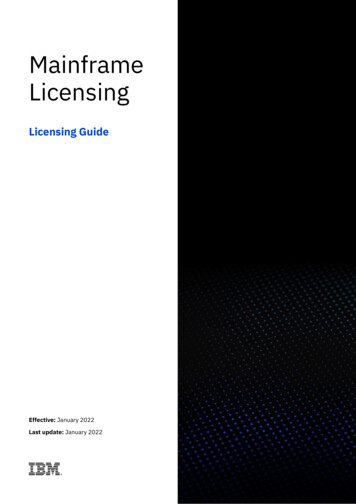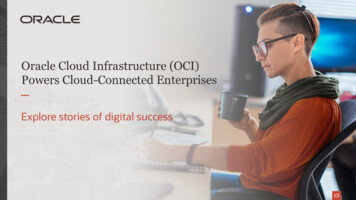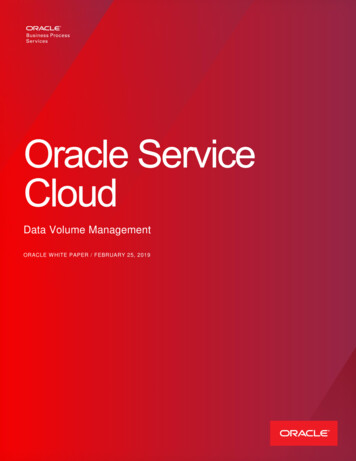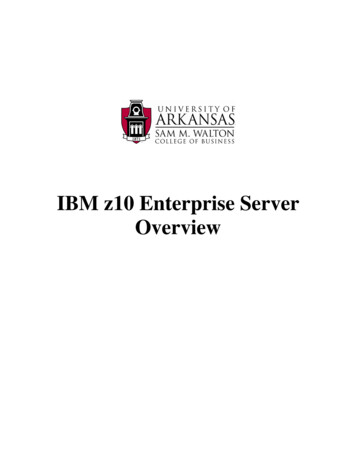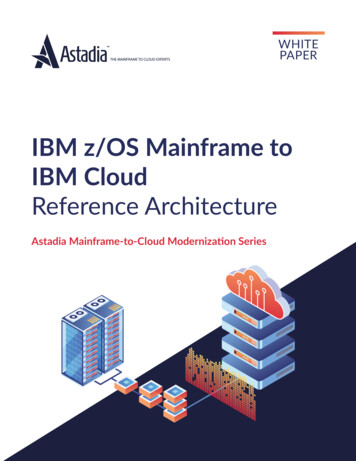
Transcription
IBM Mainframeto Oracle CloudReference ArchitectureAstadia Mainframe-to-Cloud Modernization Series
IBM Mainframe to Oracle Cloud Reference ArchitectureAbstractIn businesses today, across all market segments, cloud computing has become the focus of current andfuture technology needs for the enterprise. The cloud offers compelling economics, the latesttechnologies and platforms, and the agility to adapt your information systems quickly and efficiently.However, many large organizations are burdened by much older, previous generation platforms,typically in the form of a mainframe computing environment.Although old and very expensive to maintain, the mainframe platform continues to run the mostimportant information systems of an organization. The purpose of this reference architecture is to assistbusiness and IT professionals as they prepare plans and project teams to start the process of movingmainframe-based application portfolios to Oracle Cloud. We will also share various techniques andmethodologies that may be used in forming a complete and effective Legacy Modernization plan.In this document, we will explore:Why modernize a mainframeThe challenges associated with mainframe modernizationAn overview of the IBM mainframeThe IBM Mainframe to Oracle Cloud Reference ArchitectureAn overview of Oracle Cloud servicesA look at the Astadia Success MethodologyThis document is part of the Astadia Mainframe to Cloud Modernization Series that leverages Astadia’s25 years of mainframe platform modernization expertise. 2017 Astadia. Inc. - All rights reserved.12724 Gran Bay Parkway, Suite 300Jacksonville, FL 32258All other copyrights and trademarks the property of their respective owners.
IBM Mainframe to Oracle Cloud Reference ArchitectureContentsIntroduction . 1Why Should We Migrate Our Mainframe Apps to Oracle Cloud? . 2Benefits of Mainframe Modernization . 2Approaches to Mainframe Modernization . 2Challenges of Mainframe Modernization . 3Why Oracle Cloud? . 4Achieving the Positive Impact of Change. 5Understanding Typical IBM Mainframe Architecture . 6IBM Mainframe Heritage . 6IBM Mainframe Components . 6IBM Mainframe to Oracle Cloud Reference Architecture . 8Understanding Oracle Cloud .12Ensuring Project Success .15Astadia Mainframe-to-Oracle Cloud Success Methodology . 15Conclusion .17
IBM Mainframe to Oracle Cloud Reference ArchitectureThis page intentionally left blank.
IBM Mainframe to Oracle Cloud Reference ArchitectureIntroductionThe Oracle Cloud computing platform is an excellent target environment for transitioning from amainframe workload to a cloud implementation. With the security features of Oracle Cloud and theability to scale based on demand for the services, Oracle Cloud offers a complete operationalenvironment in support of mainframe workloads that have been migrated to the cloud. In addition,Oracle Cloud supports innovation of the application portfolio, previously held captive by the inflexiblenature of a mainframe computing model, improving the productivity of application developers andsupport personnel.Even more than a typical IT project, planning to modernize mainframe applications is the most importantphase of the total project effort. A good place to begin is with a thorough assessment of the existingoverall mainframe application portfolio. Through the assessment process, all aspects of the existingportfolio will be inventoried and examined in detail, resulting in a catalog of each application, database,technology platform and business user profile currently in use. Once completed, the results of thisapplication rationalization will then guide the sequence of application migration, as well as the differentmodernization strategies and techniques that may be called upon over the course of the entire project.We’ve included an overview of how Astadia tackles Legacy Modernization projects with our SuccessMethodology to give you an idea of what’s involved.Don’t let the enormity and importance of a mainframe modernization project deter you from gettingstarted. The skilled individuals needed to continue to maintain mainframes are increasingly leaving theworkforce through retirement and are not being replaced. Hardware and software maintenance costscontinue to escalate and the demands of customers, employees and partners require greater innovationthan mainframe platforms can support.How to Use This Reference ArchitectureBegin by reading the “Why Should I Migrate” section first. From there:Mainframe Experts: Skip to the IBM Mainframe to Oracle Cloud Reference Architecture andthe Understanding Oracle Cloud sectionsOracle Cloud Experts: Start with the Understanding Typical IBM Mainframe Architecturesection, followed by the Reference Architecture.Business Leaders: Spend time with the “Why Should I Migrate ” section and the EnsuringProject Success section at the end.About AstadiaAstadia has been in the legacy modernization business since 1994 and has successfully completed morethan 200 mainframe modernization projects. Our repeated success has allowed us to develop acomprehensive methodology, proprietary software tools and techniques, as well as the “know how” thatcomes with more than 25 years of experience handling mission critical applications and data. We’repleased to share some of that experience with you through our Mainframe to Cloud Modernization Seriesof reference architectures, webinars, whitepapers and more. Visit our website at www.astadia.com foradditional information. 2017 Astadia, Inc.1
IBM Mainframe to Oracle Cloud Reference ArchitectureWhy Should We Migrate Our Mainframe Apps to Oracle Cloud?Over the past 10 years, public cloud computing has emerged as the foundation of future enterprisetechnology. In terms of technology generations, mainframes are at least two generations old, perhapsthree. Yet, they still survive today and are responsible for running key financial, healthcare and othervital and sensitive systems around the world.So, why should you migrate your mainframe workloads, why migrate them to Oracle Cloud and why isnow the right time?Benefits of Mainframe ModernizationThe specific benefits in moving any mainframeworkload will vary between organizations andeven at the application and database level. Ingeneral, here are three of the top reasons drivinglegacy modernization projects today:Cost – The economics of cloud computing arecompelling when compared with the status quo ofmaintaining a mainframe environment. A totalcost of ownership (TCO) evaluation of thesubscription-based, consumption driven costmodel of the cloud versus the exorbitant hardware& software maintenance costs of mainframes willshow a very appealing and short-term achievableROI (potentially less than 12 months from projectcompletion).People – Mainframe-specific technical skills arenot being replaced by today’s college ortechnology trade school graduates. The pool ofavailable talent with relevant knowledge andexperience is shrinking exponentially each year.The cloud leverages modern technology and itsuse is ingrained into young software engineersworldwide.Flexibility – The cloud offers an Open Systemsenvironment in which high productivity and rapidinnovation happen at a tremendous rate. Aproperly designed implementation of a cloudinfrastructure scales easily and quickly, bothexpanding and collapsing to synchronize withbusiness demand. Backup, redundancy anddisaster recovery is seamless. Support for multipleend-user platforms and devices is inherent.Database sharing across the enterprise with highperformance is achievable.Approaches to Mainframe ModernizationYou may notice throughout this document that weuse the terms “Mainframe Modernization” and“Mainframe Migration”. Migration is a type ofmodernization,whereasmodernizationencompasses a broader set of strategies oroptions. In many cases, you will employ acombination of these strategies, the right mix of2which ones will be determined during the criticalapplication portfolio rationalization step of theproject’s assessment phase. Here are three of themost common approaches:Reuse – Often called “lift and shift”, this is ions, typically written inCOBOL, by moving them off the mainframe, andrecompiling the code to run in a mainframeemulator hosted in a cloud instance. This approachminimizes the upfront risks and the length of theproject, realizing hardware and software costsavings soonest.Running mainframe applications in an OracleCloud-hosted emulator also opens the possibilityof innovation leveraging APIs to previouslyinaccessible programs and data.Rewrite – It may be tempting to say, “Let’s justwrite new programs from scratch,” to modernizethe mainframe applications. This approach isextremely risky and fails a vast majority of thetime. It is complex, costly, and time consuming.The resources and investment required tends togreatly exceed the forecast.A new, modern codebase may still be the correctend objective, but a better approach would be tofirst move the applications to a cloud-basedemulator, migrate the database to a cloud-baseddatabase, then focus on replacing modules/codeover a deliberate, multi-phased approach. Whenit is time to rewrite, there are several codetransformation engines you can choose from toreduce the effort and minimize the risk.Replace – Another mainframe modernizationapproach is to completely replace the mainframefunctionality with a program or suite of ication. You typically see this with purposebuilt solutions for finance, human resources,manufacturing, enterprise resource planning, etc.There are also industry specific apps that maysolve the problem that a custom mainframesolution was needed for decades ago. 2017 Astadia, Inc.
IBM Mainframe to Oracle Cloud Reference ArchitectureThe upside of using SaaS is that your organizationno longer worries about maintaining code.However, you will find that while you can configurea SaaS application with various options providedby the vendor, you will not be able to customizeyour instance, as the shared codebase runs alltenants (customers/organizations) using the“service”.Application-specific ChallengesThere are a couple of general points about theapplication portfolio that should be noted. Asmentioned above, the lack of documentation onthese aging systems makes the migration effortmore difficult. The project team that drives amigration project must then resort to “mining” theactual application source code to determineexactly the behavior of the application.There are additional variations on these threemodernization approaches and you’ll likely useseveral strategies in achieving your goal tocompletely migrate from the mainframe. It iscommonly accepted best practice among legacymodernization practitioners to primarily use thelower-risk, lower-cost Reuse approach first tocapture the gains and benefits in the shortest timepossible, followed by a deliberate and phasedapproach to Rewrite or Replace the applications.Another important application-specific issue forconsideration is discovering the integrationrequirements and dependencies of the applicationwith other systems and databases. Theseintegrations and dependencies must be clearlyidentified and, if still needed, they must be reconnected (possibly rebuilt) and made operationalalong with the migrated system.Challenges of Mainframe ModernizationFor a short while, there may need to be someparallel processing between the mainframeapplication, while it is still being used inproduction, and the newly migrated system, onthe new platform. Planning and executing thisparallel processing will be a challenge, and willrequire extra time and attention to make itsuccessful.Mainframe migration projects are complex andrequire close management of the process, budgetsand timelines that have been set as project goals.A Reuse approach will involve rehosting (frommainframe to Oracle Cloud) and likely some reengineering and refactoring to complete an entiremainframe migration. It will also involve data andfile conversions for transitioning the database tothe cloud.As we’ve been emphasizing, the first challenge ofany mainframe modernization project is todevelop a rock-solid plan built upon a zation. As you put your plan together andbegin to execute, here are additional factors you’llneed to watch out for:DocumentationMany mainframe environments with large andcomplex application portfolios do not havedocumentation that details what these mainframeapplications do, and how they do it. Manyapplications are decades old, so the originalsystem, with changes likely every year, hasbecome a maintenance nightmare. The externalinteraction with these systems, the Input/Output,is how these systems get defined to the business,and the rest of the system is just a black box.Migrating a minimally-documented system of thisnature is tricky and the testing prior to the “golive” deployment is critical to mitigating this issue.(And, of course, copious documentation should becaptured for the resulting system.)Running Parallel SystemsAnother example of when you may choose to runparallel systems is if you want to achieve quickreductions in mainframe processing consumed bymoving the development and test environments toan Oracle Cloud-based emulator while keeping theproduction system on the mainframe for theinterim.Data IntegrityMoving the contents of large databases is verychallenging on a number of levels. Typically, adatabase “cleanup” will be necessary to ensurethat the contents of the new target database is asaccurate, and as complete, as possible.A mainframe modernization project is a good ��s data.Speed to CompletionIn almost every project, speed will be a toppriority. The costs and complexities of extendedproject cycles can have an enormous negativeimpact in tangible and intangible terms. As projectcycles get extended, staff attrition can become abig issue and staff fatigue may also become afactor. 2017 Astadia, Inc.3
IBM Mainframe to Oracle Cloud Reference ArchitecturePaying for a continuation of the primary productionsystem and funding the development efforts of thenew system at the same time will have atemporary financial impact for as long as thatduality continues. Getting to a “go live” statusquickly and efficiently with the new system, andretiring the old system, will keep unexpected coststo a minimum.Project FundingIt is very important for any modernization projectto be properly funded and supported by thebusiness management team and the executives.This support is essential to maintain projectcontinuity and funding throughout the projectcycle. Since we stated earlier that speed will be afactor in the project execution, funding must be inplace to sustain that speed.ExpertiseMainframe migration projects come in manyforms. In every case, a variety of specialist skillswill be needed on the project team. Thesespecialists may include business analysts workingto mine and understand the business rulesembedded in the legacy applications.It will also include experts in specific programminglanguages, databases, networks, terminal devicesand many other components of the totalapplication portfolio that will need to be addressedover the course of the migration to the targetplatform. Staff must also be available to addressany specific functionality or use case of themainframe application environment.All this technology must be transferred to theequivalent functionality on the target cloudplatform and work as it did in the originalmainframe environment. Thorough testing by theproject team, followed by testing amongst thebusiness users of the original mainframeapplication system, is an absolute requirement.Once testing is completed, a final performance andtuning (P&T) exercise will ensure that the newcloud deployment is performing at optimal levels.Why Oracle Cloud?Organizations keep discovering new and improvedbenefits for moving their mainframe (as well asother) workloads to the public cloud such ic software upgrades, cost modeloptimization, versioning control and addingmultiple security layers, just to name a few.Oracle Cloud is a recognized leader in the publiccloud space with a diverse customer base and a4broad range of use cases. Oracle has more than10,000 customers and more than 25 million usersthat rely on Oracle Cloud every day. This attractsopen source application developers as well asservice providers to make their applicationscompatible or add their services to Oracle Cloud.The benefits of migrating your mainframe toOracle Cloud are:Easy to Use – Oracle Cloud is designed withsimplicity in mind. You can request new servicesand host your applications using their simple touse web-based Oracle Cloud Portal. All theirservices are well-documented and there is awealth of forums, white papers, and discussionboards.Flexible - You can select from a wide variety ofvirtual environments where you choose thesoftware and services your application requires. Ifyou find that the environment selections are notadequate, you can simply provision different typesof instances or add compute and/or storage ondemand.Cost-Effective - Oracle Cloud services are billedusing a consumption model; you only pay for thecompute and storage resources you use with noupfrontcommitmentsandcontracts.Alternatively, if you know you have a minimal levelof needs, you can sign longer-term contracts foradditional savings.Reliable - With Oracle Cloud, you are takingadvantage of its highly redundant, worldwidecomputing infrastructure that is built to guaranteehigh availability that rivals or exceeds what you’vecome to expect from mainframes.Scalable - Oracle Cloud includes tools such asauto-scaling and load balancing that allow yourapplications to scale up or down, if youdesign/architect this into your solution. ure guarantees that resources will beavailable when they are needed.High Performance - Oracle Cloud offers a wideselection of compute and storage options toreplicate or exceed the performance needs of yourformerly mainframe-based applications. Computeand storage can be provisioned as they areneeded, so if your application is CPU intensive youcan have a larger CPU/IO ratio and vice versa.Secure - Oracle Cloud provides several securitycapabilities and services to improve privacy andnetwork traffic. These include network firewalls, a 2017 Astadia, Inc.
IBM Mainframe to Oracle Cloud Reference cryption in transit, and private or dedicatednetwork connections.Achieving the Positive Impact of ChangeIn any mainframe migration project, the results ofa cloud-based application set may be daunting.The change will impact the technical staff, as theywill likely need to learn new skills.The end-user community may not notice too manychanges using a new system if the interfaces arepreserved. In fact, the move to the cloud couldfuel new innovation resulting in new capabilitiesdown the road, which are likely not available tomainframe users today.The overall impact of a successful mainframemigration project is a positive one for the entireorganization. A new and better applicationportfolio, a cloud platform to enable innovation,and a large cost savings in the operational andsystems software maintenance categories will berealized. It’s not unusual to repurpose IT staffafter redeploying the mainframe portfolio to thecloud. The cloud platform has many other benefits,but flexibility and cost takeout are at the top of thelist. 2017 Astadia, Inc.5
IBM Mainframe to Oracle Cloud Reference ArchitectureUnderstanding Typical IBM Mainframe ArchitectureSince their development in the late 1940s, general-purpose mainframes were the computing workhorsesfor more than 50 years. Over that time, each mainframe manufacturer continuously enhanced theirunique architectures to outperform competitors and meet evolving business demands. IBM and Unisyseventually dominated the market and became the gold standards of mainframe computing. This IBMMainframe to Oracle Cloud Reference Architecture is part of the Astadia Mainframe-to-CloudModernization Series of architectures, whitepapers and webinars.IBM Mainframe HeritageIBM began producing mainframes in 1952. Theseearly models, known as the IBM 700 Series, werebased on vacuum tube technology. The nextgeneration, IBM 7000 Series, saw the introductionof transistor technology and became the mainstayof their mainframe business for many years, withsome models remaining in service up to the 1980s.In 1964, IBM announced availability of theSystem/360, with the “360” representing the ideaof 360 degrees – as in, an all-around computingsystem. Previous IBM mainframes were deliveredwith no software since it was expected that thecustomer would write all programs. Theseprograms were loaded and execute manually, oneat a time.With the release of the System/360, IBM deliveredsoftware such as compilers for programminglanguages and early operating systems. Insteadof these very expensive machines sitting idle whileoperators loaded jobs manually, programs couldbe executed using a queuing mechanism toimprove efficiency and ROI.IBM-providedsoftware quickly grew in its complexity andbecame an important piece of its mainframecomputing solutions.The System/360 also consolidated support forprocessing features, like decimal arithmetic,floating-point arithmetic, and byte addressing.These features were previously available only inmodels built for specific purposes like business orscientific calculations.As technologies and software advanced, newermodels were released as System/370 andSystem/390, culminating in the 64-bit eServerzSeries, z Systems, and IBM’s current line ofzEnterprise mainframes. The “z” refers to “zerodowntime” since the models are built withcomponents that provide hot failover capabilities.IBM Mainframe ComponentsUser InterfacesUsers access the mainframe application through avariety of means. They could use green screenterminal emulators that provide character modeinterface (TN3270).interface that allows a more user-friendly interfaceto mainframe applications. One of such userinterfaces could be a web-based or mobileapplication serving as a front end to themainframe.Alternatively, a variety of custom user interfacescould be built on top of the character mode6 2017 Astadia, Inc.
IBM Mainframe to Oracle Cloud Reference ArchitectureBatchMainframes provide batch environments thathandle bulk data processing workloads. Jobs aresubmitted to the system using JCL and processedwith minimal operator interaction. Output from thebatch jobs is spooled, printed and distributed tousers.Transaction ProcessingTransaction processing is at the core of mostmission-critical applications with thousands ormillions of transactions being processed daily. IBMmainframes provide online (real-time, ondemand)processingenvironments(mostcommonly, CICS and IMS) that make this possible.Security, transaction integrity, and predictableresponse times are of particular importance forthis type of workload.Programming g languages to suit customer needs.Most applications are written in COBOL but otherlanguages are also used: Assembler, PL/I, Natural,Fortran, REXX, etc. 4GL development productslike Mantis, Informix 4GL, and APS (AppMaster)are also used to develop mainframe applications.Data FilesMainframes store data in files with different recordorganizations and media types. Data files can besequential, direct access, fixed and variablelengths, blocked or unblocked, etc. Data files canbe stored on disks, magnetic tapes, CDROMs, etc.Some examples include VSAM, GSAM, and ISAM.For the most part, data in these files are stored inEBCDIC (Extended Binary Coded DecimalInterchange Code), an eight-bit characterencoding system used primarily on mainframes.DatabasesMainframes provide high performance databasemanagement systems to support online missioncritical applications. In general, these databasescan be hierarchical (IMS DB) or relational (DB2),and they provide high levels of availability,integrity, consistency, reliability, security, andauditing.Database software makes intensive use of thecomputing and input/output capabilities of themainframe to provide optimal response times. IBMoffers specialized processors for databaseworkloads to reduce the burden on generalprocessors.Environmental softwareMainframes require software to support themanagement, operation, application development,and security of the system.Software tools like Time Sharing Option (TSO) andInteractive System Productivity Facility (ISPF) areused by administrators and programmers tocreate, store, print and delete datasets as well assubmit batch jobs.Job scheduling software is used to automate andmanage batch job execution and workflowstreams. Output management systems handle thecollection, storage and distribution of reports tousers. Source management systems are used tomaintain application source code by trackingversion as well as release lifecycles.Terminals and terminal emulation software allowusers to interact with mainframe software andapplications.The Telnet 3250 (TN3270)communication protocol is used to communicatebetween the mainframe and a terminal session.Security is tightly controlled at all levels of themainframe software. Software provided by IBM,such as Resource Access Control Facility (RACF)and Access Control Facility 2 (ACF2) by ComputerAssociates, cooperate with system components toprovide a robust yet secure environment forapplications and data. Security software isdesigned to minimize the risk of data exposure andprovide regulatory compliance. 2017 Astadia, Inc.7
IBM Mainframe to Oracle Cloud Reference ArchitectureIBM Mainframe to Oracle Cloud Reference ArchitectureAs a Reference Architecture, the following diagrams and discussion addresses a typical use case.However, each implementation is sure to have its own customizations and variations, which is why athorough application portfolio inventory, assessment and rationalization is critical to a successfuloutcome.Below, you will see a design that includes details such as Oracle Cloud components, batch requirements,programming language conversions and replacements, integration with external systems, 3rd-partysoftware requirements, and planning for future needs.In an actual project, you would also consider any unique features that would necessitate custom-madesolutions. We would recommend proof-of-concept conversions on application subsets to test the modelselected, discover any weaknesses, and prove the viability of the design.Migrating IBM mainframe applications to Oracle Cloud:Code ModificationAs part of any mainframe modernization project,there will be a need for partial or, in some cases,extensive code modification. Leveraging our pastexperience in migrating IBM mainframes to onpremises open-systems platforms, Astadia hasdeveloped an extensive set of code transformationtechnologies and processes to successfully replatform mainframe workloads. We use these inconcert with trusted products, such as Oracle8Tuxedo and Oracle Tuxedo ART, to modify sourcecode and deploy to Oracle Cloud. What follows isa description of our approach.Astadia employs an iterative, hybrid process edTransformation Engine. 2017 Astadia, Inc.
IBM Mainframe to Oracle Cloud Reference ArchitectureThis tool preserves the business logic and rules oflegacy applications while removing proprietarycode that can only execute in the sourceenvironment and not in Oracle Cloud. Its codemigration filters ensure the preservation s such as trancodes, security policies,and message routing.Though the Rules-Based Transformation Engine(RBTE) is a proven technology, Astadia augmentsour technology with years of hands-on migrationexperience and collaboration with partners. Thecombinationofautomationandhumanintervention ensures that legacy applications willwork in Oracle Cloud without sacrificing theiroriginal functionality.Although every mainframe migration is unique,there are general source-to-target mappings forapplication components that apply to mostprojects, as shown in the following table.Code Modi
disaster recovery is seamless. Support for multiple end-user platforms and devices is inherent. Database sharing across the enterprise with high performance is achievable. Approaches to Mainframe Modernization You may notice throughout this document that we use the terms "Mainframe Modernization" and "Mainframe Migration".
